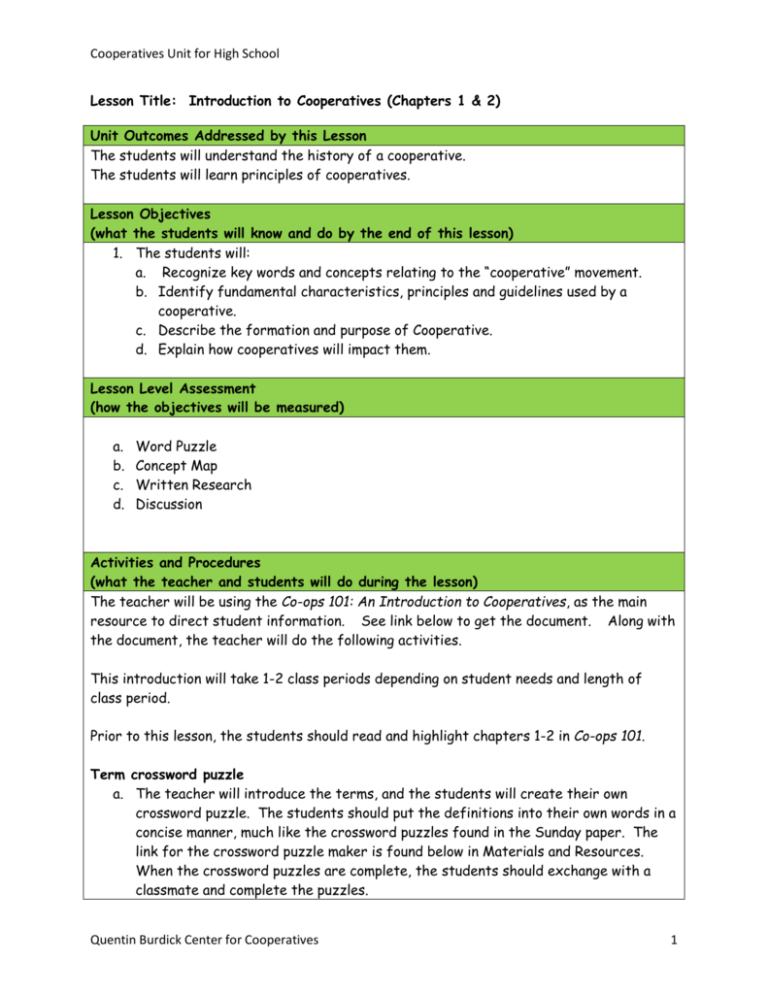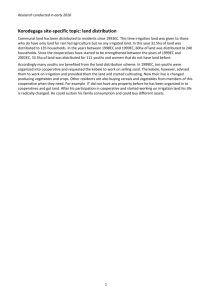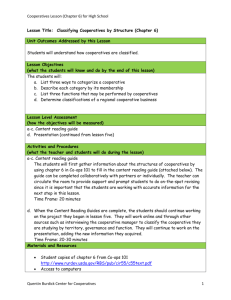MS Word - NDSU Agriculture
advertisement

Cooperatives Unit for High School Lesson Title: Introduction to Cooperatives (Chapters 1 & 2) Unit Outcomes Addressed by this Lesson The students will understand the history of a cooperative. The students will learn principles of cooperatives. Lesson Objectives (what the students will know and do by the end of this lesson) 1. The students will: a. Recognize key words and concepts relating to the “cooperative” movement. b. Identify fundamental characteristics, principles and guidelines used by a cooperative. c. Describe the formation and purpose of Cooperative. d. Explain how cooperatives will impact them. Lesson Level Assessment (how the objectives will be measured) a. b. c. d. Word Puzzle Concept Map Written Research Discussion Activities and Procedures (what the teacher and students will do during the lesson) The teacher will be using the Co-ops 101: An Introduction to Cooperatives, as the main resource to direct student information. See link below to get the document. Along with the document, the teacher will do the following activities. This introduction will take 1-2 class periods depending on student needs and length of class period. Prior to this lesson, the students should read and highlight chapters 1-2 in Co-ops 101. Term crossword puzzle a. The teacher will introduce the terms, and the students will create their own crossword puzzle. The students should put the definitions into their own words in a concise manner, much like the crossword puzzles found in the Sunday paper. The link for the crossword puzzle maker is found below in Materials and Resources. When the crossword puzzles are complete, the students should exchange with a classmate and complete the puzzles. Quentin Burdick Center for Cooperatives 1 Cooperatives Unit for High School b. Terms: 1. Corporation- group regarded as individual by law: a company recognized by law as a single body with its own powers and liabilities, separate from those of the individual members. Corporations perform many of the functions of private business, governments, educational bodies, and the professions. 2. Cooperatives- Business operated collectively: owned jointly by all its members or workers, who share all profits equally. 3. Credit Union- Type of financial cooperative 4. Grange- Agriculture cooperative stores in the 1860s 5. Limited Return- Distributing benefits proportionally to its members. 6. Patronage- Individuals who use cooperative services 7. Rochdale- An urban consumer cooperative in England in 1844. 8. User- Benefits Principle- The people benefit by gaining services that might not be available. They also benefit economically. 9. User-Control Principle- The members are the owners that control the activities. 10. User- Owner Principle- The people who use a cooperative own it Time Frame: 20 minutes to compose crossword. Concept Mapping Activity The students will create a concept map about cooperatives using information gathered while reading chapter 1. See sample below. Time frame: 20 minutes Research the Rochdale Equitable Pioneers’ Society a. The teacher will review the general history regarding cooperatives based upon the student generated concept maps. b. The teacher will assign students to research the following aspects of this topic in groups of 2-3 depending on class size: Rochdale Principles, Toad Lane Store, Rochdale Equitable Pioneers, democracy. Each group will write a one paragraph summary explaining the importance of the Rochdale Pioneers to the cooperative movement. The following rubric can be used to guide the students as they write their paragraphs. (Teachers can determine their own point values for grading.) Looks Great The topic is well-presented with 4-5 pieces of supporting important information. The writing is clear, organized and well proofread with a strong topic sentence. Pretty Good The topic is presented with 2-3 pieces of supporting information. Try Again The information doesn’t closely relate to the topic or there is too little. The writing may be somewhat disorganized or muddled because of grammatical problems. The The writing is difficult to read because of grammatical and/or organizational problems. Quentin Burdick Center for Cooperatives 2 Cooperatives Unit for High School topic sentence may be weak. The topic sentence may be missing. Time frame: 20 minutes to gather information and write paragraphs. When the student groups complete their paragraphs, have them share their work with the class and combine the paragraphs to form one essay about Rochdale. Wrap-Up Discussion Teacher and students will examine the impact of cooperatives on their lives. Students will compose one question and one comment based upon their current understandings of cooperatives. See below for exit activity. Time Frame: 10 minutes Materials and Resources Webpage Resources Student copies of chapters 1 & 2 from Co-ops 101 http://www.rurdev.usda.gov/RBS/pub/cir55/c55text.pdf www.ag.ndsu.nodak.edu/qbcc/NDCCC/coopmonth.htm http://www.puzzle-maker.com/ www.nsacoop.org Slips of paper for One Question and One Comment Access to the internet and computers for researching Rochdale and writing paragraphs Quentin Burdick Center for Cooperatives 3 Cooperatives Unit for High School Concept Map Guidelines (Can use SmartArt in Microsoft Word 2007 or students can handwrite their own maps) Cooperatives Main point 1 Main point 2 Supporting details Supporting details Main point 3 (etc.) Supporting details Write one conclusion you drew as a result of the information you have learned so far about cooperatives. Then compose one question that the information has raised for you. Record your question and comment on the slip of paper provided and be ready to share with the class. Contributing Authors: Mary Grosgebauer and William Fritz Quentin Burdick Center for Cooperatives 4 Cooperatives Unit for High School Summative Questions (Chapters 1 & 2) 1. One fundamental principle of a cooperative: a. Grange b. User- Benefits c. Limited Returns 2. The origin of cooperatives is most often linked to: a. Rochdale b. National Farmers Union c. Wal-Mart 3. The purpose of a cooperative is to: a. Too limit competition b. Provide serves that private investor-owned companies find profitable c. Reduce purchasing costs through volume buying 4. Characteristic associated with cooperatives: a. Closed membership b. Open membership c. Union membership 5. Local granges were _____________________ to serve rural members: a. Elevators b. Banks c. Stores 6. Limited Return distributes benefits _________________ to its users: a. All at once b. Not at all c. Proportional 7. List at least 3 examples of cooperatives a. b. c. 8. List 5 characteristics of a cooperative a. b. c. d. e. Quentin Burdick Center for Cooperatives 5 Cooperatives Unit for High School Summative Questions (Chapters 1 & 2) KEY 1. One fundamental principle of a cooperative: a. Grange b. User- Benefits c. Limited Returns 2. The origin of cooperatives is most often linked to: a. Rochdale b. National Farmers Union c. Wal-Mart 3. The purpose of a cooperative is to: a. Too limit competition b. Provide serves that private investor-owned companies find profitable c. Reduce purchasing costs through volume buying 4. Characteristic associated with cooperatives: a. Closed membership b. Open membership c. Union membership 5. Local granges were _____________________ to serve rural members: a. Elevators b. Banks c. Stores 6. Limited Return distributes benefits _________________ to its users: a. All at once b. Not at all c. Proportional 7. List at least 3 examples of cooperatives a. Credit Unions b. Health (Blue Cross/Blue Shield, HMOs) c. Agriculture (Farmers Union, Cenex, CHS) d. Electrical (RCA, Northern Plains) e. Telecommunications 8. List 5 characteristics of a cooperative a. Open membership b. One member/one vote c. Cash trading d. Membership Education e. Political and Religious neutrality f. No unusual risk assumption g. Limitation on the number of shares owned h. Limited interest on stock i. Goods sold at regular retail prices Quentin Burdick Center for Cooperatives 6 Cooperatives Unit for High School j. Net margins distributed according to patronage Quentin Burdick Center for Cooperatives 7







